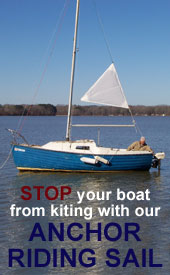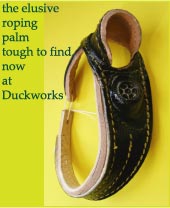
 Custom Search
|
|
| sails |
| plans |
| epoxy |
| rope/line |
| hardware |
| canoe/Kayak |
| sailmaking |
| materials |
| models |
| media |
| tools |
| gear |
 |
 |
| join |
| home |
| indexes |
| classifieds |
| calendar |
| archives |
| about |
| links |
| Join Duckworks Get free newsletter Comment on articles CLICK HERE |
|
|
| Valora's Log |
by David Nichols - Austin, Texas - USA The Sea Anchor |
 |
| Most blue water sailors feel any boat that ventures off shore needs a sea anchor or drogue for heavy weather and I completely agree. Valora's equipment list didn't include any heavy weather gear. That meant I needed to either purchase or make a sea anchor or drogue. I relied heavily on two books for my information; Storm Tactics by Lin and Larry Pardey and Heavy Weather Tactics Using Sea Anchors and Drogues by Earl R. Hinz. I did a fair amount of research on line as well. I think I found Storm Tactics the most useful because Valora is similar to the Pardey's boat in size and underwater profile. Valora's full keel has a cut away forefoot but is more traditional than say boats with a fin keel and skeg mounted rudder. That doesn't mean the other book wasn't useful because both books are indispensable and have a permanent place in Valora's library.
So the subject of heavy weather sailing and storm tactics is much like lighting grounding; everybody has opinion and sometimes those opinions conflict. There also seems to be some disagreement what constitutes a sea anchor and a drogue but generally a sea anchor is deployed from the bow and a drogue is trailed off the stern while running. The key word there is generally. After sorting through a lot of opinions and reading material I came to the conclusion that I didn't want to use a parachute style sea anchor. A boat Valora's size seemed to need a chute with a bare minimum size of 9 feet and most sources recommend a 12 to 15 foot parachute. I felt this would hard to deploy (particularly in a storm), hard to store, and can fail to deploy properly. What I settled on was a combination of the Jordon series drogue and a 36 inch Delta Drogue deployed off the bow using a Pardey Bridle to keep Valora in a hove-to position, which is approximately 45 degrees to wind and waves. All my reading suggests heaving-to is the best heavy weather strategy for traditional, heavy displacement hulls. Valora's 10,500 pounds on 28.5 feet definitely puts her into the Large Lady category. But not all traditional Large Ladies will maintain a heave-to position because the wind and wave pushes the bow down wind. The Pardeys found that a parachute anchor off the bow with a bridle that holds the boat about 45 degrees to wind and waves works very well. The sea anchor keeps the wind and waves from knocking the bow down wind. This tactic has become known as a sea anchor with a Pardey Bridle.
I have substituted a Jordon series drogue attached to a 36 inch Delta Drogue in place of the Pardey's military surplus parachute. I made the series drogue and bought the Delta Drogue. A quick Google of Jordan Series Drogue will provide a mountain of information on the history and development, theory, tests, and anecdotes from those who have used it in real storms. Basically, the series drogue is, strangely enough, a series of small flexible cones, about 5 inched in diameter at the mouth, attached to a 5/8 inch double braded line. The basic drogue uses 100 small cones on about 300 feet of line. This is trailed off the stern with a strong bridle and the boat drifts slowly before the wind. That means I'm deploying the series drogue off the wrong end of the boat. Well maybe, but I don't think so. I started with 50 cones and two larger cones (about 10 inches at the mouth) because I am using the Delta Drogue along with the series drogue. That should slow my drift to 1 knot or 2 knots at the most. The idea here is just to keep the bow into a hove-to position. I may add some more small cones, if after a test or two, I find I need more. My gut level feeling is I won't need any more cones but that remains to be seen. I could have bought a complete Jordan Series Drogue from several sources but I decided to make it myself. I had two options making it myself; make it from scratch or buy a kit from Sailrite Kits. I made it from scratch with a bunch of sail cloth I had left over from another project.
I did buy the webbing from Sailrite and relied heavily on the video they have online. I find the people at Sailrite most helpful. I checked a number of sources for the 5/8 double braid and found Duckworks had the best price. I have always found Duckworks to be a great resource. When all the sewing and assembly was done I was amazed at how much space it occupied. There is a special storage/deployment bag that you can make or buy but I sewed a special canvas bag that worked better for Valora.
I stored the bag in Valora's large lazarette and thankfully never needed to take it out. I had hoped to practice deploying it but the opportunity never presented itself. A few practice runs in good weather will be the order of business before an off shore run. My use of the Jordan Drogue and my strategy are completely out of the box and need to be tested in a controlled situation. It would be foolish to sail off into the sunset never having tested or practiced deploying this equipment. If the time comes when it needs to be used then like the lighting grounding I'll know I did everything I could. Valora is well found and very strong so I believe she'll care for her crew in a bad blow. My gear and the Pardey Bridle will help her do just that. The Pardey system does seem to light up the forums with those who swear by it and those who condemn it. It seems that the whole subject of heavy weather at sea is so scary that many sailors cling to their own particular tactic with a religious fervor. Anybody doing something different means the status quo system might not be the best and that is, apparently, a frightening thought so anything different is condemned by some. But boats are like individuals and what works for one might not work for another. One size does not fit all. So it's test and modify until I find the combination that works best for Valora. David's plans are in the Duckworks Store Click Here for a List of Articles and Columns by David Nichols |






